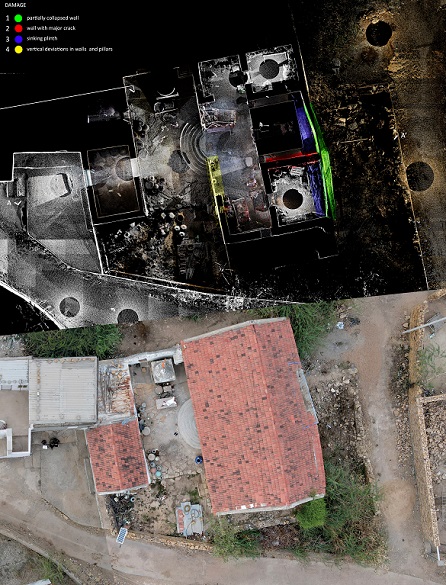Expert Blog: Architectural heritage under a new light
Dr Bernadette Devilat, an expert in digital architecture, explains the benefits of scanning heritage sites for preservation purposes
Published on 23 June 2022
Categories: Press office; Research; School of Architecture, Design and the Built Environment;

Digital Bela: architectural heritage under a new light is an exhibition that explores the 3D laser scanning record of Bela, located in the semi-desertic region of Kutch, in the State of Gujarat, India. It offers an overall image of its historical area. It features the in-depth record of houses and small religious temples as examples of a total of 18 buildings scanned in detail in June 2021 during five days on-site.
This record is complemented with photographs, videos, aerial drone imagery, social surveys and interviews with local people to develop a re-construction methodology, which is the aim of the research project: ‘A sustainable re-construction method for seismic-prone heritage areas of India based on advanced recording technologies’. It is a fast, affordable and scalable methodology to break the unsustainable cycle of buildings’ replacement and subsequent heritage loss. This research project considers re-construction as the repair, reinforcement and risk management of structures instead of their complete replacement, which is a common and inadequate post-earthquake response.
One of the tools used is 3D laser scanning — also known as LiDAR — which allows a fast capture of the built environment in the form of a measurable and coloured 3D point cloud: an accurate and comprehensive digital data set that offers a technical platform for damage assessment, design, risk mitigation measures and community engagement. The proposed methodology could improve the chances of a rapid and effective response in case of an earthquake, enhance the possibilities of reusing existing structures, and increase preparedness and resilience in local communities while virtually preserving its culture embedded as the record of a ‘living heritage’.

3D laser scan plan and aerial drone view of the same temple. By B. Devilat, F. Lanuza, M. Mane, Z. Pithawalla, R. Khatri & A. Desai
This project also tests a strategic partnership between academia, governmental institutions, and NGOs to inform actions and policies in conserving at-risk cultural heritage, involving planning, designing and building local capacity. Based on this key institutional framework, this work is relevant to further investigate this methodology’s scalability and broader applicability in other similar seismic-prone heritage settlements.
A similar exhibition was presented to the community of Bela in November 2021, which included community engagement activities; and also to our partners in Ahmedabad, India. By sharing and discussing our work with the inhabitants, we have tried to incorporate local knowledge for the communities’ risk preparedness in the face of earthquakes, inviting them to further engage with the representations of their village to value their traditional environment. Booklets compiling the plans, sections and images of each individual structure based on the 3D scan data were given to the owners and carers of those buildings, and used to have conversations regarding their condition and potential risks over two field trips at Bela.
The exhibition is displayed for the first time here at Nottingham Trent University (NTU). The exhibition is open to the public at the Coffee pod area, Level 1 Newton Building (City Campus) until the 30th of June 2022, Monday to Friday, from 7.30 am to 9 pm. The research project is funded by the UKRI Arts and Humanities Research Council (AHRC) and the Department for Digital Culture, Media and Sport (DCMS). Reference: AH/V00638X/1
By Dr Bernadette Devilat of the School of Architecture, Design and the Built Environment.
RESEARCH TEAM:
CAUGH NTU: Dr Bernadette Devilat (PI), Prof Mohamed Gamal Abdelmonem (Co-I), Dr Felipe Lanuza; ICCROM: Dr Rohit Jigyasu (Co-I) & Sukrit Sen; Center for Heritage Conservation, CEPT Research and Development Foundation (India): Dr Jigna Desai (Co-I), Mrudula Mane & Zeus Pithawalla. Project Partners: Hunnarshala Foundation & GIDM (India). More information at: www.3d4heritageindia.com